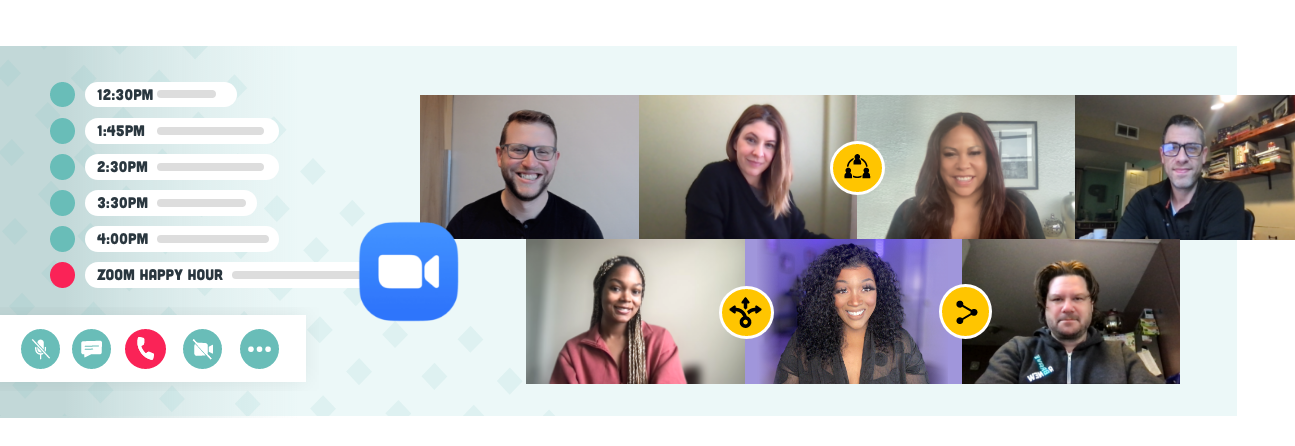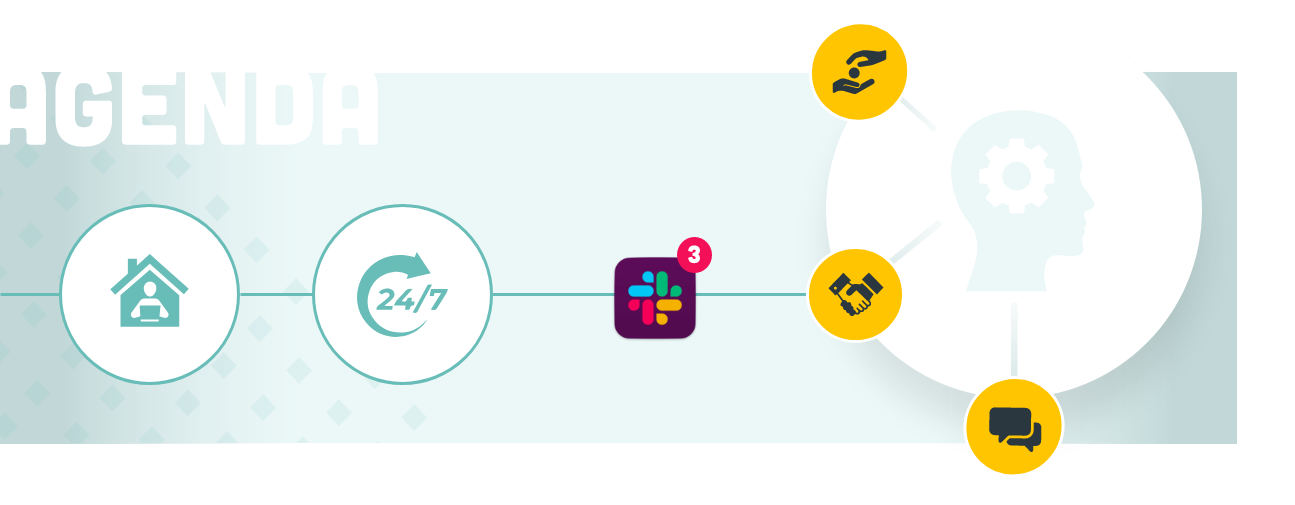There’s no doubt. The pandemic changed and is still changing a lot. Work is changing, the way we work is evolving. We all went home to work virtually, and most of us stayed there.
More organizations are now adopting a “hybrid” approach to work, which combines the physical location of a traditional office with the flexibility and freedom of working from anywhere.
This is a big shift for workplaces at large, and it’s having ripple effects on the ways organizations operate, hire, and retain talent. Many of us naturally adjusted our approach to virtual and hybrid working and recruiting during the pandemic, but we didn’t really have an intentional, long-term plan. So as organizations like ours embrace a broader virtual hiring policy, we also need to intentionally plan for how to effectively operate as hybrid, or even fully virtual organizations.
I recently sat down to talk with Tara Powers, CEO of the Powers Resource Center and expert on virtual and hybrid teaming. (You can read or listen to our full interview here.) She shared so much wisdom that we are definitely taking to heart as we plan for a working environment that takes advantage of virtual but also gives us that in-person collaboration and connection we crave.
Whether your team has gone totally virtual, you’ve started hiring for virtual, or you are maintaining some office space for a hybrid approach, it’s fair to say that no one is really hurrying back to the office full time. (And, if you’re forcing employees to do that, you’re probably dealing with a lot of resistance or turnover). Here are some takeaways from my conversation with Tara as well as a look at how we’re approaching our new hybrid and virtual teams in a more intentional way in 2022.

1. Foundational Considerations to Set You Up for Success
For those of us who thought we’d save time, money, and energy by going remote, think again. Hybrid and virtual teams need just as much attention and care to build trusting, healthy relationships as they did in person. Maybe more. We’re still human, after all.
- Planning and budgeting for in-person connection. If you’re like some of us, or our clients, you saved some money by downsizing space or eliminating office space entirely over the last couple of years. But hybrid teams require intentionality and that still requires a budget.
Tara says, “Any business from this point forward has to budget and have a very clear strategy for what hybrid looks like. When does it make sense to bring us together? And when we are together, we should not just be having useless meetings. We should not just be doing nothing, like coming in and just working on stuff I can do at home. When we bring people together in the office, we are doing amazing things.”
Because of the pandemic and the great resignation, we now have the opportunity to get talent from anywhere. But we need to budget for when we're bringing people together. Because the worst thing we can do is say, “Well, we're going to bring 85% of us together who live here, but there are 15% that don't, so you guys can just call in.” That's not going to fly anymore to build the kind of team connection and trust that the in-person time is meant to deliver. - Onboarding. You absolutely cannot onboard people the same way you were doing it when you were in the office. You have to completely transform and plan for very specific and strategic connection points as people are onboarded into your company. You might get the whole team together virtually and do a team building activity with the new person or a meet and greet so they can get to know everyone. You can also have them meet with each person virtually, strategically at a certain time for a specific reason.
Everyone has a role to play in the onboarding experience, more so virtually than ever in person — when you could just leave it up to HR to onboard them for two weeks and then plop them into your team ready to go. They're learning something from each person and building a connection. Maybe your role is going to be to talk to them about the culture, because you've been here the longest. Another role is going to be to talk about the clients that we serve and some of their nuances, because that's your area of expertise.
This requires companies to get much better at onboarding people to a team and building team trust quickly. You can use tools and assessments to help people integrate or quick team-building strategies. One great way to help new team members learn quickly is to assign them to a buddy that is there for them, checking in with them every day that first week of work so that they feel like they've hit the ground running and have a resource for simple questions.

2. Supporting Connection and Engagement
If you’re like some of us, you went home at the beginning of the pandemic and missed seeing everyone. So we started Zoom happy hours and had Zoom dates. And then everything was on Zoom, and we were constantly connected and looking at people’s faces close up all the time. Zoom fatigue started to set in and the happy hours and face-to-face meetings dwindled.
- Staying connected virtually. We can’t just take everything we did when we were in the office in person and just shift it online. We need to think about effective ways to stay connected virtually for the long term. And how people feel connected really varies from employee to employee.
Tara says, “We have to be intentional and thoughtful with our teams about what feels good in terms of connection, because psychological safety is still such a huge component of how we brainstorm, solve problems, make decisions, share information, work together virtually and in person.” We need to make sure we’re connecting regularly and intentionally without burning people out with meetings that don’t serve the purpose of connection and just feel thrown on the calendar to solve a problem. - Psychological safety. According to Tara, “psychological safety is what we need to go work for a company and stay at a company.” We have to focus on creating psychological safety in a virtual environment. That can look like people feeling comfortable to speak up in meetings and having the opportunity to speak up. In our virtual meetings, we need to work on creating an environment where everyone gets a chance and there's an expectation that their voice is heard. Everyone. Even if we have to change our meeting structure or timing.
A Google study from some years back found that that psychological safety was the #1 factor in what makes a successful team. As a result, Google organized their hiring, work, meetings, recognition, and everything they were doing to ensure there was an environment to hear equal voices in the room. To ensure participative decision-making. To ensure clarity around contribution and values. To make sure people were appreciated and recognized for what they did.
Another thing we have to be bold about — if we have leaders in our organization who are toxic, they need to go. Keeping toxic leaders is not going to work anymore. Tara says, “We’ve got to get rid of the toxic leaders and really start to embrace this idea that people want to contribute, they want their voice to be heard. They want to be appreciated and valued for the work that they do.” In fact, we should want that from all of our employees. - Employee recognition. What really keeps us engaged while we are doing our work is recognition. And surprisingly, it’s not all about recognition from your manager. Unfortunately, many of us don’t recognize our employees enough or, just as bad, do it really inconsistently.
Have your team take your next half-hour meeting and focus on brainstorming some ways that you can recognize each other individually. Talk about what is important to each of you individually. Ask what kind of team recognition would appeal to everyone? At the end, ask for one or two people to volunteer to be the leaders around this for at least the next quarter. A lot of times, recognition from peers is way more powerful and impactful than recognition from a leader. Getting peers involved in helping create it, making sure it happens, and reminding leaders to make sure it happens is a really good idea.
Recognition really doesn't have to break the bank. Most people just want a really sincere thank-you. Here's how you made a difference: to the team, to our clients, to our business. Here's why I love having you as part of this team and why it makes such a difference to me. Just that sincere thank-you is so valuable.
 3. Guardrails for Effective Work
3. Guardrails for Effective Work
- Efficiency. This could take several forms, but we should always be rethinking efficiency. What is not needed is a virtual environment that is daunting rather than invigorating. We’re not talking about working all the time and always having to be “on” or available, that’s not healthy either. But have we really stepped back and adapted our work environments to some of the advantages of virtual work? What doesn’t work as well anymore? What works better?
One place to look is at meetings. Tara asked a friend who worked with Deloitte “What tips do you have? ” And she shared, “It's amazing how they run their meetings. We never ever have a meeting to talk about an update. Our meetings are only 30 minutes. And the only thing we do in meetings is we come with an idea or a solution to a problem to get feedback. That is the only reason we meet. We never update each other on progress. That is something that doesn't need to be happening virtually that can be happening using technology.” - Agreements. Last, but certainly not least, Tara talks about the need for agreements (small contracts) around expectations that are essential for a healthy hybrid or virtual environment.
After you answer these questions and have gotten team feedback, make sure to document your agreements, train your team, and put systems in place to reinforce these behaviors. This isn’t to be dogmatic, it’s to make sure each employee knows what’s expected of them, and it gives them safe parameters to ask for that treatment in return. - Communication agreement — What do we agree are the right communication tools and methods to use? What meetings should we have our cameras on? When is it ok to conference call? When is it ok to just Slack? How do we deal with misunderstanding when we’re virtual and Slack or email doesn’t fully carry the right tone? How are we using technology to communicate and when are we talking?
- Connection agreement — What connection do we need with each other, and what feels best so we feel cared for, understood, and safe? This has to be intentionally someone’s job, or it will be forgotten. Some companies have found success rotating the connection lead each month and have a stated number of social connection activities they’re expected to facilitate so that things feel fresh and don’t just become another meeting to check off.
Also, employees can’t choose to just not do any social stuff. You’re still part of the team and need to build trust and you can’t do that simply over text or Slack. - Contribution agreement — When are people expected to contribute? Can they come to every team meeting with camera off and not say anything at all? Can they always just observe? What participation is required?
This is another great place to ask people what contribution they need from their peers and not just make this an area of top-down expectations. Employees that are highly engaged often feel unsupported by team members who don’t contribute equally, and it’s more helpful for people to hear that from their peers than from leadership. - Availability agreement — People working from home can feel like they have to be available 24/7. We need to make sure we’re clear about expectations so that we can help people create healthy boundaries.
One place to start is office hours. Depending on the time zone of your headquarters, or even your big clients, setting the hours that people should be available helps them manage their day. Leaders also need to set the bar and abide by the availability agreement by scheduling their emails for business hours, rather than sending late at night or on weekends, which makes employees feel like they can never log off.
Certainly, we’ll be a lot more comfortable with our hybrid work lives in the next five years, and we can look to companies like Automattic — who have been living in this virtual/hybrid work world for some time — for guidance.
The most important reminder from Tara is that “most of us still want to get up every day and feel fulfilled and happy.” People want to do work that is meaningful, that they enjoy, and that showcases their skills. As our workplaces evolve, we are happy to see companies embracing more of a give-and-take relationship that respects and appreciates people’s whole beings. Work is just one component of our lives. A large component, but by acknowledging our whole selves, we hope to bring more lightness and peace to all of our lives.
If you want to learn more from Tara and her wonderful team at Powers Resource Center, their website has great resources such as virtual scorecards, more tools for hybrid and virtual teams, and information about how to conduct virtual meetings.
If you’re looking for some other input on how to collaborate with an agency, with freelancers, or even within your own marketing team, check out our resource, How We Work With Clients (And Why It Works).
Don’t miss out, get Brave News now
Join the ABN community and be the first to learn about trends in inbound marketing, branding, and web design.






